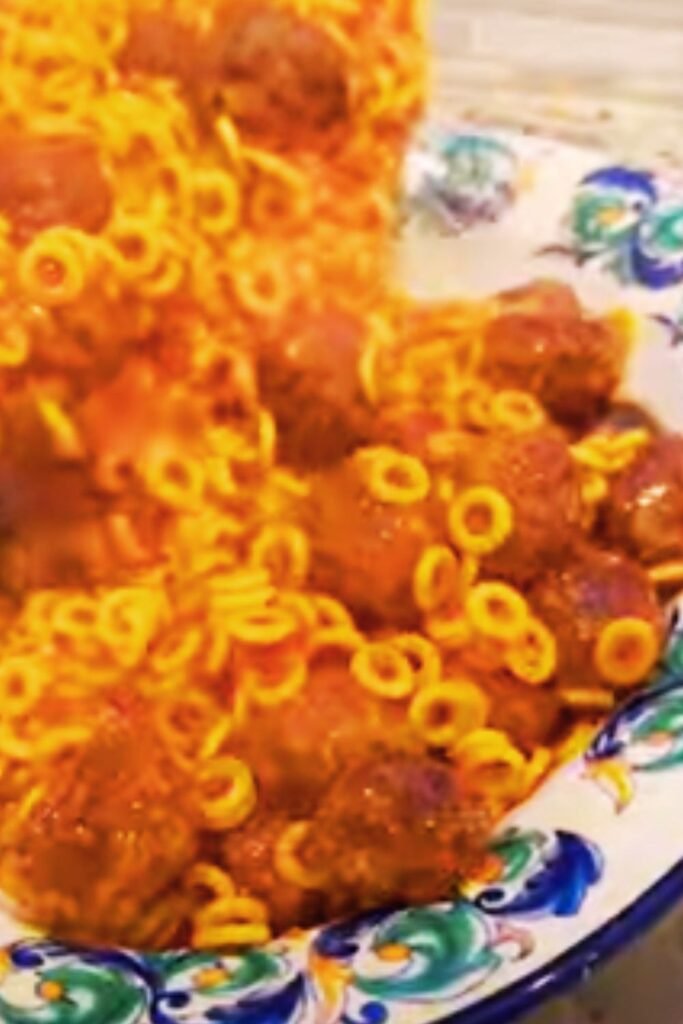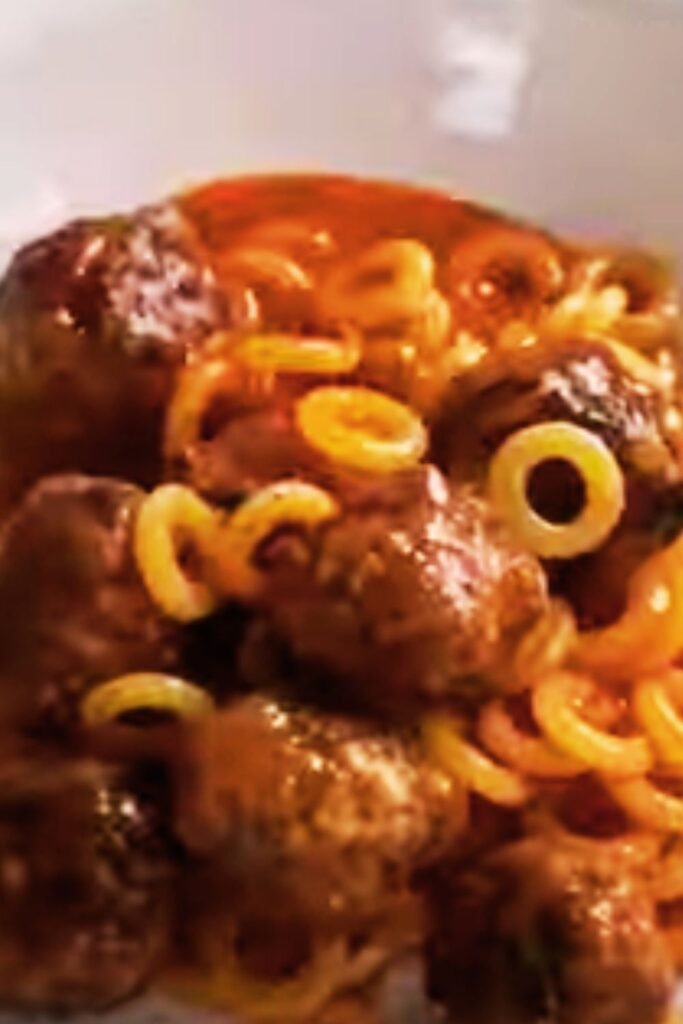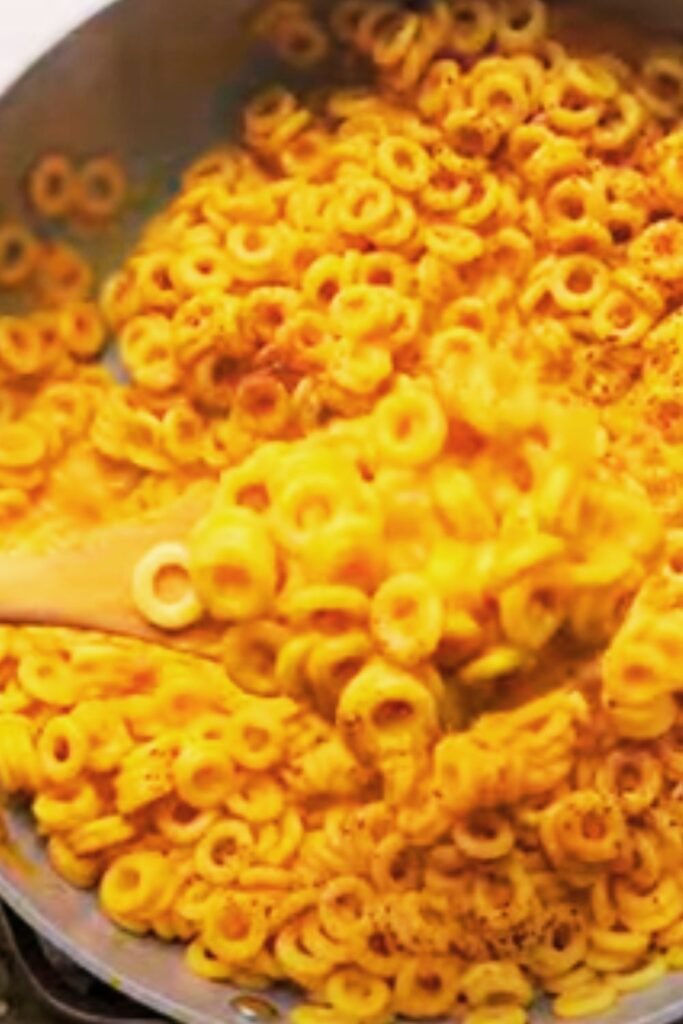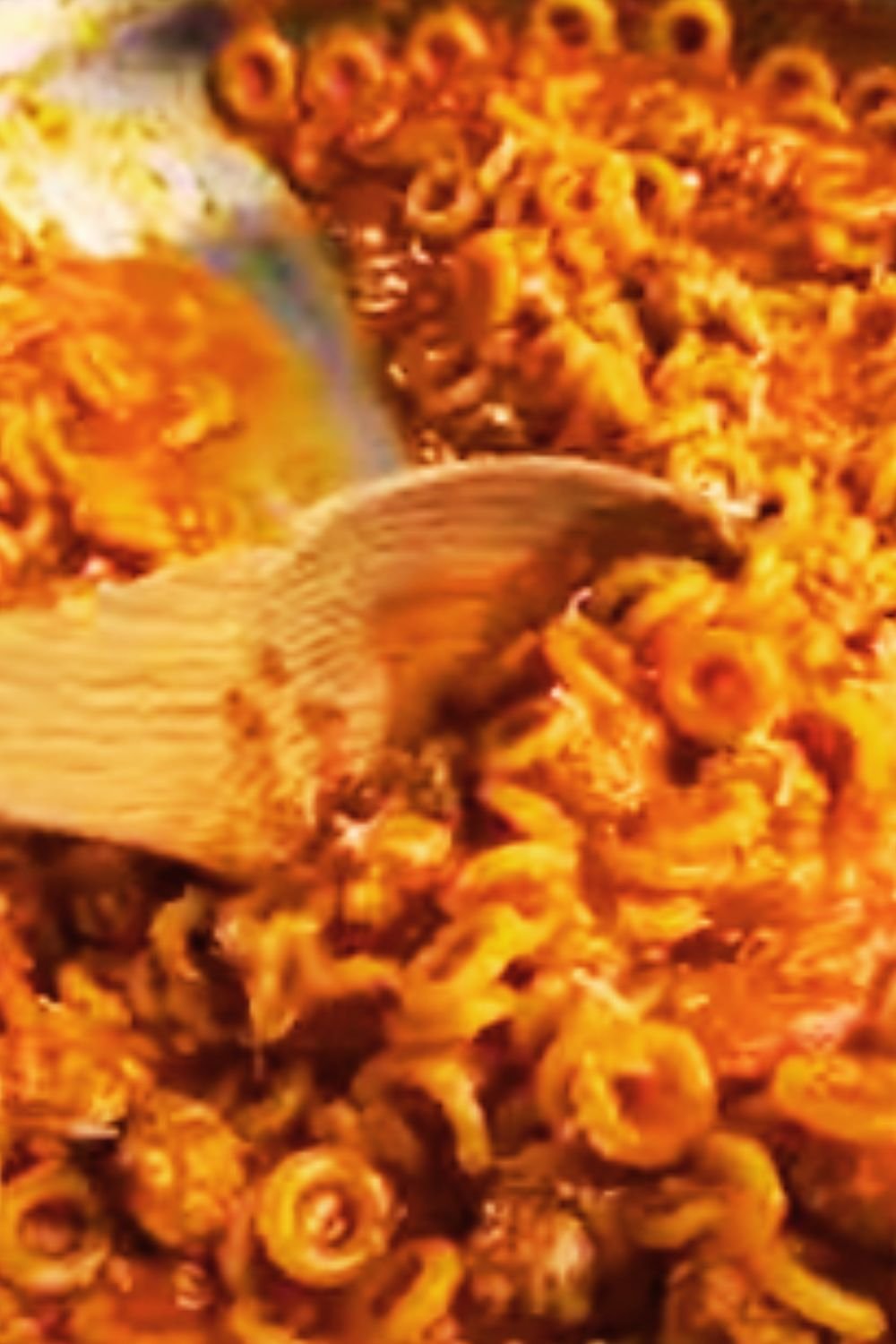Do you remember that distinct ring-shaped pasta swimming in tomato sauce from your childhood? I sure do! SpaghettiOs were a staple in my home growing up, and while the canned version certainly has its nostalgic appeal, I’ve discovered that making them from scratch isn’t just possible—it’s absolutely delicious and surprisingly simple.
Today, I’m sharing my favorite homemade SpaghettiOs recipe that captures all the comfort of the original but with fresher ingredients and none of the preservatives. This recipe has become my go-to when I’m craving something nostalgic yet wholesome, and it’s been a massive hit with my family too!
Why Make SpaghettiOs From Scratch?
When I first considered making homemade SpaghettiOs, I wondered if it was worth the effort. After all, the appeal of the original is partly its convenience. But after my first batch, I was completely converted for several compelling reasons:
- Control over ingredients: No preservatives, lower sodium, and you can adjust the flavors to your preference
- Fresher taste: The difference in flavor between canned and freshly made is remarkable
- Customizable: You can make it healthier by adding hidden vegetables or adjusting the sauce consistency
- Cost-effective: Making a big batch costs less than buying multiple cans
- Fun cooking project: It’s surprisingly satisfying to recreate this childhood classic
The Perfect Pasta Shape
Finding the right pasta is perhaps the most distinctive challenge in recreating SpaghettiOs. While the original uses “anellini” (tiny ring pasta), this can be difficult to find in regular grocery stores. Here are your options:
| Pasta Type | Availability | Notes |
|---|---|---|
| Anellini | Specialty stores, Italian markets, online | The authentic choice—tiny pasta rings that perfectly mimic the original |
| Ditalini | Most grocery stores | Small tube-shaped pasta that works well; cut cooking time slightly |
| Acini di pepe | Many grocery stores | Tiny bead-shaped pasta that provides a similar texture |
| Mini alphabet pasta | Kid’s pasta section | Fun alternative that children especially enjoy |
| Cut spaghetti | DIY option | In a pinch, break thin spaghetti into small pieces |
I usually opt for ditalini when I can’t find anellini, and honestly, the experience is just as satisfying!
Ingredients You’ll Need

For the sauce (serves 4-6):
- 2 tablespoons olive oil
- 1 small onion, finely diced
- 2 cloves garlic, minced
- 1 carrot, finely grated (optional but adds natural sweetness)
- 1 celery stalk, finely diced (optional for flavor depth)
- 2 tablespoons tomato paste
- 1 can (28 oz) tomato sauce or crushed tomatoes
- 1 cup vegetable or chicken broth
- 1 tablespoon butter
- 1 teaspoon dried oregano
- 1/2 teaspoon dried basil
- 1 bay leaf
- 1/2 teaspoon sugar (balances acidity)
- 1/2 teaspoon salt (adjust to taste)
- 1/4 teaspoon black pepper
- 1/4 cup heavy cream or half and half (optional for creaminess)
For the pasta:
- 2 cups small ring pasta (anellini) or substitute
- Water and salt for boiling
My Step-by-Step Method
Making the Sauce
- Heat olive oil in a large saucepan over medium heat.
- Add diced onion and cook until translucent, about 3-4 minutes.
- Add minced garlic, grated carrot, and celery (if using), and cook for another 2 minutes until fragrant and softened.
- Stir in tomato paste and cook for 1 minute to deepen the flavor.
- Pour in the tomato sauce/crushed tomatoes and broth, stirring to combine.
- Add oregano, basil, bay leaf, sugar, salt, and pepper.
- Bring to a gentle simmer, then reduce heat to low and cook uncovered for 20-25 minutes, stirring occasionally.
- Remove bay leaf and transfer sauce to a blender (or use an immersion blender directly in the pot).
- Carefully blend until completely smooth.
- Return sauce to the pot, stir in butter until melted, and add cream if using.
- Keep warm on low heat while preparing the pasta.
Cooking the Pasta
Getting the pasta texture right is crucial for authentic SpaghettiOs:
- Bring a large pot of water to a rolling boil.
- Add 1 tablespoon salt to the water.
- Add pasta and cook according to package directions, but aim for slightly firmer than al dente (the pasta will continue cooking slightly in the sauce).
- Drain but do not rinse the pasta.
- Immediately add pasta to the warm sauce and stir gently to combine.
- Let the mixture sit for 2-3 minutes to allow the pasta to absorb some sauce.
The Secret to That Authentic Taste
I’ve found through much experimentation that the following tricks make homemade SpaghettiOs taste remarkably similar to the canned version:
| Secret Ingredient | What It Does | Amount |
|---|---|---|
| Butter | Creates silky texture and rich mouthfeel | 1 tablespoon |
| Sugar | Balances acidity and adds slight sweetness | 1/2 teaspoon |
| Cream | Gives that distinctive creamy quality | 1/4 cup |
| Thoroughly blended sauce | Ensures smooth consistency | Blend for 30-60 seconds |
| Brief final simmer | Allows pasta to absorb flavor | 2-3 minutes |
The butter and cream might seem unusual in a tomato sauce, but trust me—they’re critical for achieving that nostalgic flavor profile we all remember!
Making It Healthier

One major advantage of homemade SpaghettiOs is the ability to boost nutrition without sacrificing flavor. Here are my favorite nutritional upgrades:
- Hidden vegetables: The finely grated carrot already in my recipe adds vitamins without changing the flavor much. You can also add 1/2 cup finely diced red pepper or 1/4 cup grated zucchini.
- Protein boost: Add 1/2 cup of cooked ground turkey or 1 cup of white beans (pureed into the sauce for picky eaters).
- Whole grain option: Use whole wheat tiny pasta shapes (though taste will differ slightly).
- Lower sodium: Reduce salt and use low-sodium broth and tomatoes.
- Dairy-free version: Replace butter with olive oil and skip the cream or use coconut cream instead.
Make-Ahead and Storage Tips
Homemade SpaghettiOs actually improve with time as the flavors meld together! Here’s how to store them:
- Refrigerator: Store in an airtight container for up to 4 days. The pasta will absorb more sauce over time, so when reheating, you may need to add a splash of water or broth.
- Freezer: Freeze portions in freezer-safe containers for up to 3 months. For best results, slightly undercook the pasta before freezing.
- Reheating: Heat gently on the stovetop with a little added liquid, stirring occasionally. Microwave works too—cover loosely and heat in 30-second intervals, stirring between.
- Sauce-only option: For maximum flexibility, make a large batch of just the sauce and freeze it, then cook fresh pasta when ready to eat.
Kid-Friendly Variations
As someone who loves cooking for young ones, I’ve discovered a few fun twists that make this recipe even more appealing to children:
- Alphabet pasta: Use alphabet pasta instead of rings for an educational mealtime.
- Mini meatballs: Add tiny homemade or store-bought meatballs for a heartier dish.
- Cheese please: Sprinkle with a little grated parmesan or melt in small cubes of mild cheddar.
- Shapes and faces: Serve with cucumber slices or pepper strips arranged as a face on the plate.
- Color twist: Add a little pureed spinach or butternut squash to the sauce for natural color variations.
Serving Suggestions

While delicious on its own, I like to round out the meal with some simple sides:
- Grilled cheese triangles for dipping
- Simple green side salad with light vinaigrette
- Steamed broccoli florets (kids sometimes enjoy “trees” in their “O’s pool”)
- Garlic bread for a more substantial meal
- Apple slices with cinnamon for a sweet contrast
- Sparkling water with lemon for a refreshing drink
Troubleshooting Common Issues
Even with a straightforward recipe like this, little problems can arise. Here’s how I address them:
| Problem | Cause | Solution |
|---|---|---|
| Sauce too thick | Too much reduction or pasta absorption | Add broth or water, 1 tablespoon at a time |
| Sauce too thin | Not enough reduction or too much liquid | Simmer uncovered to reduce, or add 1 teaspoon cornstarch mixed with 1 tablespoon cold water |
| Pasta too soft | Overcooked pasta | Cook a fresh batch, reducing time by 1-2 minutes |
| Acidic taste | Tomato variation or not enough sweetness | Add 1/4 teaspoon more sugar or a pinch of baking soda |
| Bland flavor | Underseasoned | Add salt and pepper incrementally, and consider a dash of garlic powder |
Why This Recipe Works Every Time
Having made this recipe countless times, I’ve discovered what makes it foolproof:
- Blending the sauce thoroughly: This creates that signature smooth texture that defines SpaghettiOs.
- Slightly undercooking the pasta: It will continue softening in the hot sauce.
- Adding butter and cream: These ingredients create that distinctive velvety mouthfeel.
- Balanced seasoning: The combination of herbs, salt, and touch of sugar perfectly mimics the original flavor.
- Final simmer with pasta: This crucial step allows the pasta to absorb the flavor of the sauce.
I’m convinced that once you try this homemade version, you’ll never want to go back to the can. The freshness and flavor are incomparable, and the satisfaction of creating a childhood favorite from scratch is truly special.
Questions & Answers
Q: Can I make this recipe vegan?
Yes! Replace the butter with olive oil or vegan butter, skip the cream or use coconut cream instead, and ensure your pasta doesn’t contain eggs. The flavor profile will be slightly different but still delicious.
Q: How can I make this in an Instant Pot?
Great question! Sauté the aromatics using the Sauté function. Add remaining sauce ingredients (except cream), then add pasta and just enough extra broth to barely cover pasta. Pressure cook on High for half the normal pasta cooking time. Quick release, stir in butter and cream, and let stand 5 minutes before serving.
Q: My kids are picky eaters. Any tips for getting them to try this?
Involve them in the process! Let them help measure ingredients or stir the pot (supervised, of course). Calling it “Homemade SpaghettiOs” rather than “pasta with tomato sauce” can also help, as can serving it in a special bowl with their favorite spoon.
Q: Is this recipe suitable for canning?
I don’t recommend canning the complete dish with pasta, as the texture would suffer. However, you can pressure can just the sauce following proper canning guidelines, then add fresh cooked pasta when ready to serve.
Q: How different does this really taste from the canned version?
It’s remarkably similar in concept but fresher and more vibrant in flavor. Most people find they prefer the homemade version once they try it, though it does lack some of the distinctive “canned” flavor that comes from preservatives and industrial cooking methods—which I consider a good thing!
Q: Can I double or triple this recipe?
Absolutely! The sauce freezes beautifully, so making a large batch is time-efficient. Just ensure you use a pot large enough to handle the volume and consider cooking the pasta separately in batches if needed.
Q: What’s the best way to send this in a school lunch?
Warm it thoroughly in the morning and place in a pre-heated insulated food container. The pasta may absorb more sauce by lunchtime, so make it slightly soupier than normal. Test your container beforehand to ensure it keeps food hot enough (above 140°F) until lunchtime.
Q: Can adults really enjoy this too, or is it just for kids?
This is definitely an all-ages pleaser! For adult palates, consider adding a dash of smoked paprika, a sprinkle of red pepper flakes, or finishing with fresh basil and good quality olive oil. Paired with a simple salad, it makes a comforting weeknight dinner that satisfies nostalgic cravings.
I hope this recipe brings as much joy to your kitchen as it has to mine! There’s something magical about recreating childhood favorites with wholesome ingredients—it connects us to fond memories while creating new ones. Happy cooking!


